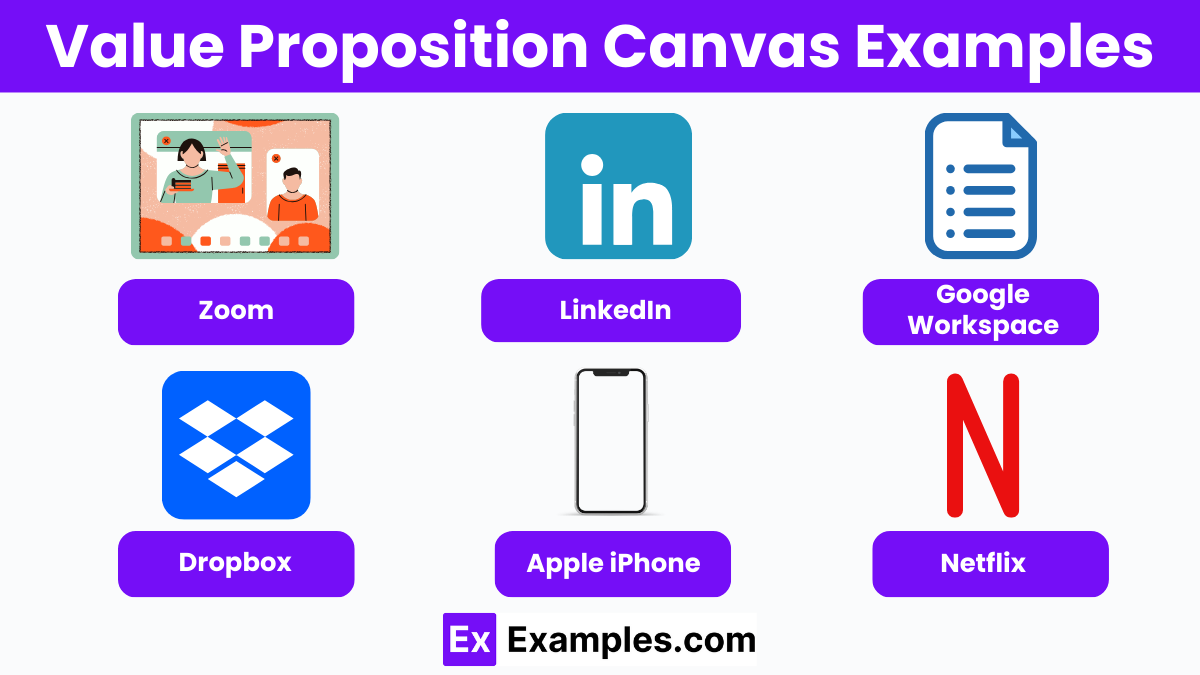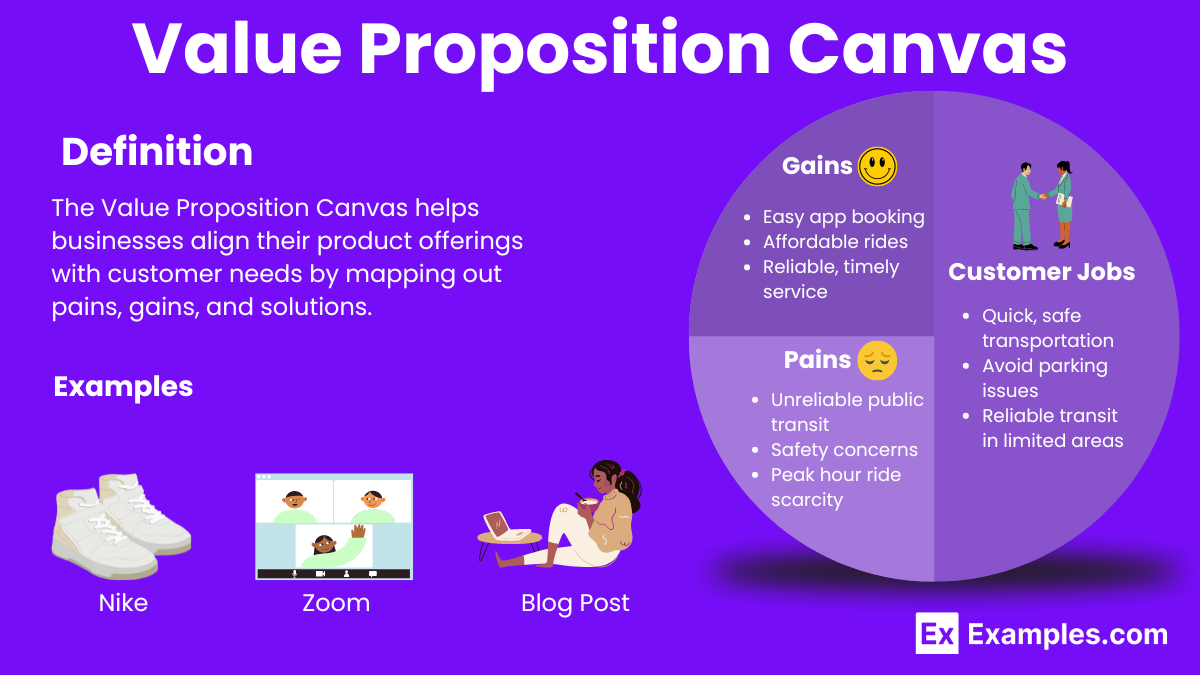18+ Value Proposition Canvas Examples to Download
The Value Proposition Canvas is a strategic tool that helps businesses align their products or services with customer needs. It provides a visual framework to ensure a compelling value proposition statement by detailing customer segments, pains, gains, and how the product addresses these. Integral to the business model, this canvas enhances understanding of customer expectations, ensuring tailored solutions that drive satisfaction and success. It bridges the gap between the product and its market fit effectively.
What is the Value Proposition Canvas?
The Value Proposition Canvas is a strategic tool that helps businesses align their product offerings with customer needs, detailing how the product addresses customer pains and gains, ensuring a compelling and market-fit value proposition.
Value Proposition Canvas Examples

- Apple iPhone – Enhances user experience with innovative features and sleek design.
- Netflix – Offers diverse entertainment with easy accessibility and personalized recommendations.
- Tesla Model S – Provides eco-friendly transportation with high performance and cutting-edge technology.
- Amazon Prime – Delivers fast shipping and exclusive content for a seamless shopping and viewing experience.
- Starbucks – Offers premium coffee with a personalized and cozy café experience.
- Spotify – Provides vast music library with personalized playlists and offline listening.
- Dropbox – Simplifies file storage and sharing with easy access across devices.
- Nike – Delivers high-quality athletic wear with stylish design and performance enhancements.
- Airbnb – Offers unique and affordable accommodations with a local experience.
- Uber – Provides convenient and reliable transportation with easy booking and cashless payments.
- Slack – Enhances team collaboration with real-time messaging and integrations.
- Google Workspace – Streamlines productivity with integrated tools for communication and collaboration.
- LinkedIn – Connects professionals with networking opportunities and career advancement resources.
- Zoom – Facilitates seamless virtual meetings with high-quality video and a.
- Peloton – Combines fitness equipment with live and on-demand workout classes.
- Salesforce – Enhances customer relationship management with robust data and automation tools.
- Adobe Creative Cloud – Provides comprehensive design tools with cloud-based access and collaboration.
- Blue Apron – Offers meal kits with fresh ingredients and easy-to-follow recipes.
- Grammarly – Enhances writing with advanced grammar and style checking tools.
Value proposition canvas business plan
- Identify Customer Segments – Conduct thorough observation to understand distinct groups of potential customers and their specific needs.
- Define Customer Jobs – Determine the tasks, problems, and goals that customers aim to accomplish with your product or service.
- Analyze Customer Pains – Identify the challenges and pain points customers face in achieving their goals.
- Highlight Customer Gains – Outline the positive outcomes and benefits customers desire from using your product or service.
- Map Product Features – List the key features of your product that address customer pains and provide desired gains.
- Align Features with Pains and Gains – Ensure each product feature directly addresses a specific customer pain or gain, enhancing customer service.
- Develop Value Proposition Statement – Craft a clear and compelling statement that encapsulates how your product solves customer problems and delivers benefits.
- Validate with Customers – Present your value proposition to target customers for positive feedback and refinement.
- Iterate Based on Feedback – Use customer feedback to make necessary adjustments to your product and value proposition.
- Implement and Monitor – Launch your value proposition, continuously observing customer interactions and feedback to ensure ongoing alignment with customer needs and improvements in customer service.
Value Proposition Canvas Structure
- Customer Segments – Identify the specific groups of users, such as digital illustrators, who will benefit from your product. Understand their unique needs, preferences, and challenges.
- Customer Pains and Gains – Analyze the problems illustrators face, such as complex UI design, and the benefits they seek, like intuitive tools and efficient workflows.
- Value Proposition – Develop a clear statement that outlines how your product, featuring user-friendly UI design and specialized tools for digital illustrators, solves their problems and enhances their productivity.
- Product Features – List the essential features and functionalities of your product, such as advanced drawing tools, seamless integration with other software, and customizable interfaces that address the specific needs of digital illustrators.
- Fit and Validation – Ensure alignment between your product features and the identified customer pains and gains. Validate this fit through user testing and feedback to refine and perfect your value proposition.
Value Proposition Canvas for Uber
Customer Segments
- Commuters
- People without cars
- Tourists
- Event attendees
- Business professionals
Customer Jobs
- Quick, safe transportation
- Avoid parking issues
- Reliable transit in limited areas
- Easy ride booking via app
- Consistent availability
Customer Pains
- Long wait times
- High costs of taxis or car ownership
- Unreliable public transit
- Safety concerns
- Peak hour ride scarcity
Customer Gains
- Easy app booking
- Affordable rides
- Reliable, timely service
- Safe with driver ratings and GPS
- Convenient cashless payments
Uber’s Value Proposition
- Easy Booking: User-friendly app
- Affordable Rides: Competitive pricing
- Reliable Service: GPS and driver ratings
- 24/7 Availability: Rides anytime
- Cashless Payments: Convenient and secure
Product Features
- Intuitive app UI
- Driver rating system
- Real-time GPS tracking
- Variety of ride options
- Secure app payments
Value Proposition Canvas for a Food Delivery Service
Customer Segments
- Busy professionals
- Students
- Families
Customer Jobs
- Quick meals without cooking
- Variety of cuisines
- Easy online ordering
Customer Pains
- Limited time
- Boredom with meals
- Concerns about food quality
Customer Gains
- Fast, convenient delivery
- Diverse menu options
- Fresh, quality food
Value Proposition
- Easy Ordering: User-friendly app/website
- Variety: Multiple cuisines
- Reliable: Timely delivery
- Quality: Fresh ingredients
- Healthy Choices: Nutritious meals
Product Features
- Intuitive platform
- Diverse menu
- Prompt delivery
- Quality control
- Health-focused options
Advantages and Disadvantages of Value Proposition Canvas
| Aspect | Advantages | Disadvantages |
|---|---|---|
| Clarity and Focus | Provides clear understanding of customer needs and product fit | Can oversimplify complex customer needs and solutions |
| Alignment | Ensures alignment between product features and customer expectations | Requires accurate customer insights, which can be difficult to obtain |
| Communication | Enhances communication within the team about value proposition | May lead to excessive focus on current customers, ignoring new segments |
| Innovation | Encourages innovative thinking by identifying unmet needs | Can limit creativity if strictly followed without flexibility |
| Customer-Centricity | Puts customer needs at the center of product development | Potentially neglects internal business constraints and resources |
Tips For Using The Value Proposition Canvas
- Understand Your Customer Segments – Thoroughly research and define your target customer groups.
- Identify Customer Pains and Gains – Clearly outline the challenges and desired outcomes of your customers.
- Align Product Features – Ensure your product features directly address customer pains and provide gains.
- Use Real Customer Feedback – Validate your assumptions with actual customer input and adjust accordingly.
- Keep It Simple and Clear – Avoid overcomplicating; maintain clarity in your value proposition and canvas elements.
- Iterate Regularly – Continuously refine and update the canvas based on evolving customer needs and market trends.
- Engage Your Team – Collaborate with your team to gather diverse insights and perspectives.
- Focus on Customer Jobs – Understand what customers are trying to accomplish and tailor your offerings to help them succeed.
- Visualize the Process – Use the canvas as a visual tool to map out and communicate your value proposition effectively.
- Balance Creativity and Structure – Follow the canvas guidelines while allowing room for creative solutions and innovations.
Why is the Value Proposition Canvas important?
It helps businesses create compelling value propositions that meet customer expectations.
How do you define customer segments in the canvas?
Identify distinct groups of customers with specific needs, preferences, and behaviors.
What are customer pains and gains?
Pains are challenges customers face, while gains are the benefits they seek from a product or service.
How does the Value Proposition Canvas improve product development?
It ensures that product features directly address customer needs and provide
What are the main components of the Value Proposition Canvas?
Customer Segments, Customer Jobs, Pains, Gains, and Value Proposition.
How do you use customer feedback in the Value Proposition Canvas?
Validate assumptions, refine the value proposition, and ensure alignment with customer needs.
Can the Value Proposition Canvas be used for services?
Yes, it is applicable to both products and services.
How often should you update the Value Proposition Canvas?
Regularly, based on changing customer needs and market trends.
How do you map customer jobs in the canvas?
Identify the tasks, problems, and goals customers aim to achieve with your product.


